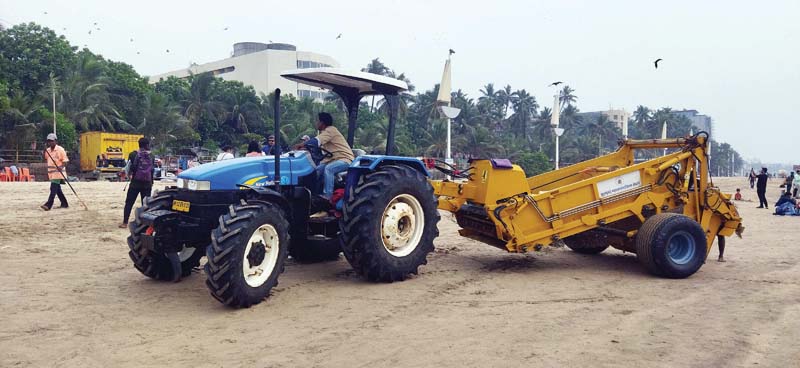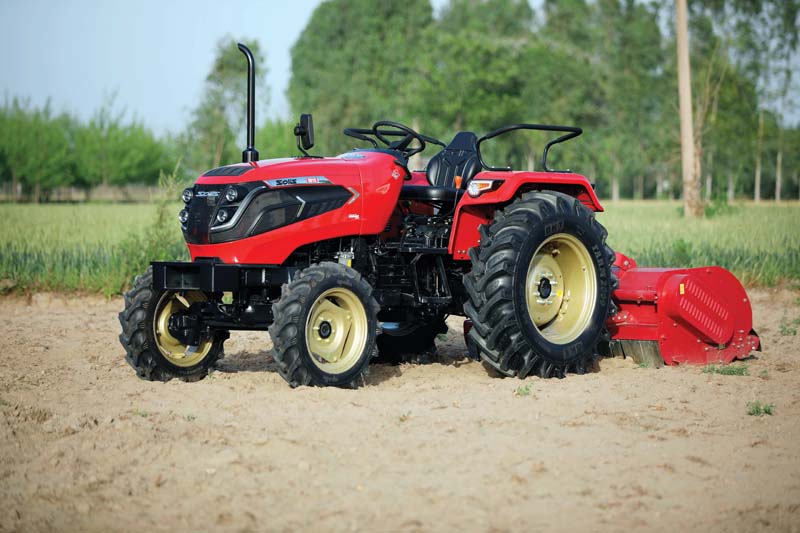The farming equipment industry is at a crucial juncture. Ashish Bhatia looks at the direction it is taking.
 The Farming Equipment (FE) segment is a crucial driver of an agricultural country like India. It is a key contributor to the country ranking second in the world. With the nation aiming to turn a USD five trillion economy, one can’t overlook the USD 400 billion contributions of agriculture, only second after China. Tractor manufacturers must be credited for driving the transformation in the industry on a Year-Over-Year (YoY) basis. Like other automotive segments, this sub-segment is re-engineering the rules of the game. From aspects like form factor, overall design, touch and feel, coloured wheels (aftermarket), closed cabins and air-conditioned cabins to electric and autonomous machines are not far-fetched anymore. From prototypes, they have come a long way to witnessing commercialisation. The TREM Stage III A emission compliance with effect 2010-11 and the rollout of electric tractors are important steps in the direction of zero-emission. For tractors with greater than 50 hp engines, new compliances are expected to be rolled out. It has made India the first nation outside of the EU to adopt such stringent measures.
The Farming Equipment (FE) segment is a crucial driver of an agricultural country like India. It is a key contributor to the country ranking second in the world. With the nation aiming to turn a USD five trillion economy, one can’t overlook the USD 400 billion contributions of agriculture, only second after China. Tractor manufacturers must be credited for driving the transformation in the industry on a Year-Over-Year (YoY) basis. Like other automotive segments, this sub-segment is re-engineering the rules of the game. From aspects like form factor, overall design, touch and feel, coloured wheels (aftermarket), closed cabins and air-conditioned cabins to electric and autonomous machines are not far-fetched anymore. From prototypes, they have come a long way to witnessing commercialisation. The TREM Stage III A emission compliance with effect 2010-11 and the rollout of electric tractors are important steps in the direction of zero-emission. For tractors with greater than 50 hp engines, new compliances are expected to be rolled out. It has made India the first nation outside of the EU to adopt such stringent measures.

Coupled with a winning combination of sustainable manufacturing footprint at leading tractor manufacturing plants this radicle evolution has gone well beyond just intent to execution. The repealing of farm laws and the expectations of a good harvest season have also given this segment a fillip. Classified as essential, the FE segment sustained through a tumultuous, pandemic marred 2020-22. Agriculture and allied activities are said to have been the sole bright spot amid the slide in the GDP performance of other sectors. They clocked a growth rate of 3.4 per cent at constant prices during 2020-21. With a growth of CAGR of 7.5 per cent over the last decades, the industry from being a 50,000 volume market through the 1960s is today well over ~6,00,000 volumes. From being a net importer, it has turned into a net exporter and at par with markets like the United States and China with the exception of the growing sub-20hp segment. The volumes span from sub-20 hp to 60hp plus variants on offer catering to diverse needs from orchard fields to larger land holdings. Here 80 per cent of the sales are known to come from the 30-50 hp segment. The goal is to double farm mechanisation in a span of 10 years which can result in a 30 per cent boost in productivity and farming cost reduction by 20 per cent expected to drive up profitability in the sector. Notably, the industry has succeeded in localising 95 per cent of farming equipment in the country.

Through a ‘Custom Hiring’ scheme, the government is prioritising small- and medium-landholders. The strategy is to double the coverage of farmland under mechanisation. The scheme is expected to provide expensive and large advanced agricultural equipment to the framers on a rental basis. This trend is vastly adopted in the bus segment on similar lines with the exception of the operator running the show. In the case of STUs, buses are added to their fleets on a Gross-Cost Contract (GCC) basis wherein the operator is paid a specified sum for a specified period. To increase the availability of equipment/machines to the small and marginal farmers on the above-mentioned hire basis, as per the Economic Survey 2020-21 study, an estimated 9970, 2866 and 4170 custom hiring centres are said to have been initiated in Punjab, Haryana and UP respectively.
The needs of farmers have come a long way and so has the supply chain that has aligned itself with this demand-driven market. Today, considerations span across parameters like sustenance, 4WD, commercial and agricultural applications, and design. Attempting to fulfil these requirements, the Tractor and Mechanization Association (TMA) in its data for a Year-To-Date (YTD) basis has found a firm ground to build on in the coming quarters. In the adjoining table, you will see that the tractor manufacturers started the year with higher production volumes compared to sales. Production volumes matched sales leading into the new Financial Year 2022 (FY2022).
 In an upward trajectory, the industry was selling higher than it produced before a slight dip in May-June 2022 and took off again. In June 2022 sales are pegged at 1,07,326 units compared to the production volumes of 1,03,563 units (including exports). The industry exported 12,849 units in the same month. With half yearly performance left to be witnessed,on a YTD basis, the industry sold 5,10,541 units with a production of 4,75,441 units and exports of 67,315 units. This is in comparison to the whole of 2021 when the industry sold 10,28,625 with a production of 10,65,280 units and exports of 1,24,901 units. Animesh Agarwal, Founder and Chief Operating Officer, Tractor Junction on tractor sale expectations said, “The tractor sales in India have been on a slow wicket, it was down by over 10 per cent YoY for June due to a higher base, and delayed arrival of the monsoon. For July too, the expectation is expected to be on similar lines – uneven distribution of rains, flooding, and a higher base of July 2021 may impact sales for July 2022.” Expressing hope in the situation normalising as the season progresses, he pinned hopes on volumes picking up in August and September. “Supply-side issues getting addressed, inflation peaking out and economic growth picking pace augurs well for an overall recovery in the rural economy. Tractor sales provide a mirror image of the rural economy,” he opined.
In an upward trajectory, the industry was selling higher than it produced before a slight dip in May-June 2022 and took off again. In June 2022 sales are pegged at 1,07,326 units compared to the production volumes of 1,03,563 units (including exports). The industry exported 12,849 units in the same month. With half yearly performance left to be witnessed,on a YTD basis, the industry sold 5,10,541 units with a production of 4,75,441 units and exports of 67,315 units. This is in comparison to the whole of 2021 when the industry sold 10,28,625 with a production of 10,65,280 units and exports of 1,24,901 units. Animesh Agarwal, Founder and Chief Operating Officer, Tractor Junction on tractor sale expectations said, “The tractor sales in India have been on a slow wicket, it was down by over 10 per cent YoY for June due to a higher base, and delayed arrival of the monsoon. For July too, the expectation is expected to be on similar lines – uneven distribution of rains, flooding, and a higher base of July 2021 may impact sales for July 2022.” Expressing hope in the situation normalising as the season progresses, he pinned hopes on volumes picking up in August and September. “Supply-side issues getting addressed, inflation peaking out and economic growth picking pace augurs well for an overall recovery in the rural economy. Tractor sales provide a mirror image of the rural economy,” he opined.
To stack up the numbers as desired, the industry is focused on the progress of the monsoon and the Kharif crops. Releasing its tractor sales figures for the month of June 2022, Mahindra & Mahindra Ltd’s FE sector registered a dip in figures. The company sold 39,825 units compared to the sale of 46,875 units in the same period last year (June 2021). The figure stood at 41,848 units as compared to 48,222 units including exports. Commenting on the performance, Hemant Sikka, President – Farm Equipment Sector, Mahindra & Mahindra Ltd. stated, “With good prices for the rabi output, the cash flow with farmers is good. The government’s approval of an increase in MSP for all Kharif crops and the forecast of a normal monsoon is very positive for a bumper Kharif crop. Though Kharif sowing is lagging in the first fortnight of the season than last year due to deficient rainfall in key Kharif states, further advancement of southwest monsoons across the country brings in positive sentiments and is likely to boost the tractor demands in the coming months. In the exports market, we have sold 2,023 tractors (including CKD) with a growth of 50 per cent over last year.”
The world’s largest tractor manufacturer by volume had a reason to rejoice further. The company bagged four awards at the third edition of the Indian Tractor Of The Year (ITOTY) 2022 including the ‘Fastest Growing Tractor Manufacturer’ Award for Swaraj Tractors. (More details are in the winner’s list that follows below*). With a presence in over 50 countries across six continents, the U.S. is the largest market for the company outside India. The company has an on-ground presence in North America, Brazil, Mexico, Finland, Turkey, and Japan through subsidiaries. It has manufacturing facilities in Mumbai, Nagpur, Rudrapur, Jaipur and Zaheerabad, India.

Brand Swaraj Tractors recently launched the 744 XT, in the 50 hp segment in Nepal. Claimed to boast among the largest engine for its category, the 3478 cc displacement is aimed at offering maximum performance in Agri and haulage applications. To give a sense of the progression of tractors, the latter comes with a constant mesh transmission, multispeed forward and reverse PTO, dual-clutch, oil immersed disc brakes, power steering with a high ground clearance courtesy of bigger front tyres. It also comes with a directional control valve and a best-in-class lift capacity of 1.7-tonne. The tractor is capable of handling heavy implements with ease and precision as per company claims. On the warranty front, the company is offering a best-in-industry six-year coverage.
Leading exporter Sonalika Tractors registered its highest ever first-quarter sales in Q1FY2023. It clocked an overall sales of 39,274 units, an 18 per cent growth above 33,219 overall tractor sales recorded in the corresponding period FY2022. Raman Mittal, Joint
Managing Director, International Tractors Ltd. states, “Achieving our highest ever Q1 overall sales of 39,274 units with 18 per cent growth is a testament that we understand farmers and their regional market requirements well. Strategically supported by our unique approach to customising our tractor portfolio, I am optimistic that we have set our FY2023 course in the right direction for upcoming seasons later during the year.” He committed to addressing regional farmer requirements to ensure high productivity and income for their buoyant future. A testimony to the plans progressing in the right direction, the company bagged an impressive four awards including ‘Exporter of The Year’. (More details are in the winner’s list that follows below*).



















